As poultry owners, especially those who raise flocks for meat, a process is inevitable: killing chickens. Of course, owners would have to go through this part at one point in the whole process of raising chickens for meat. For sure, owners want to do this activity in the humane ways available. Here are four ways to kill a chicken.
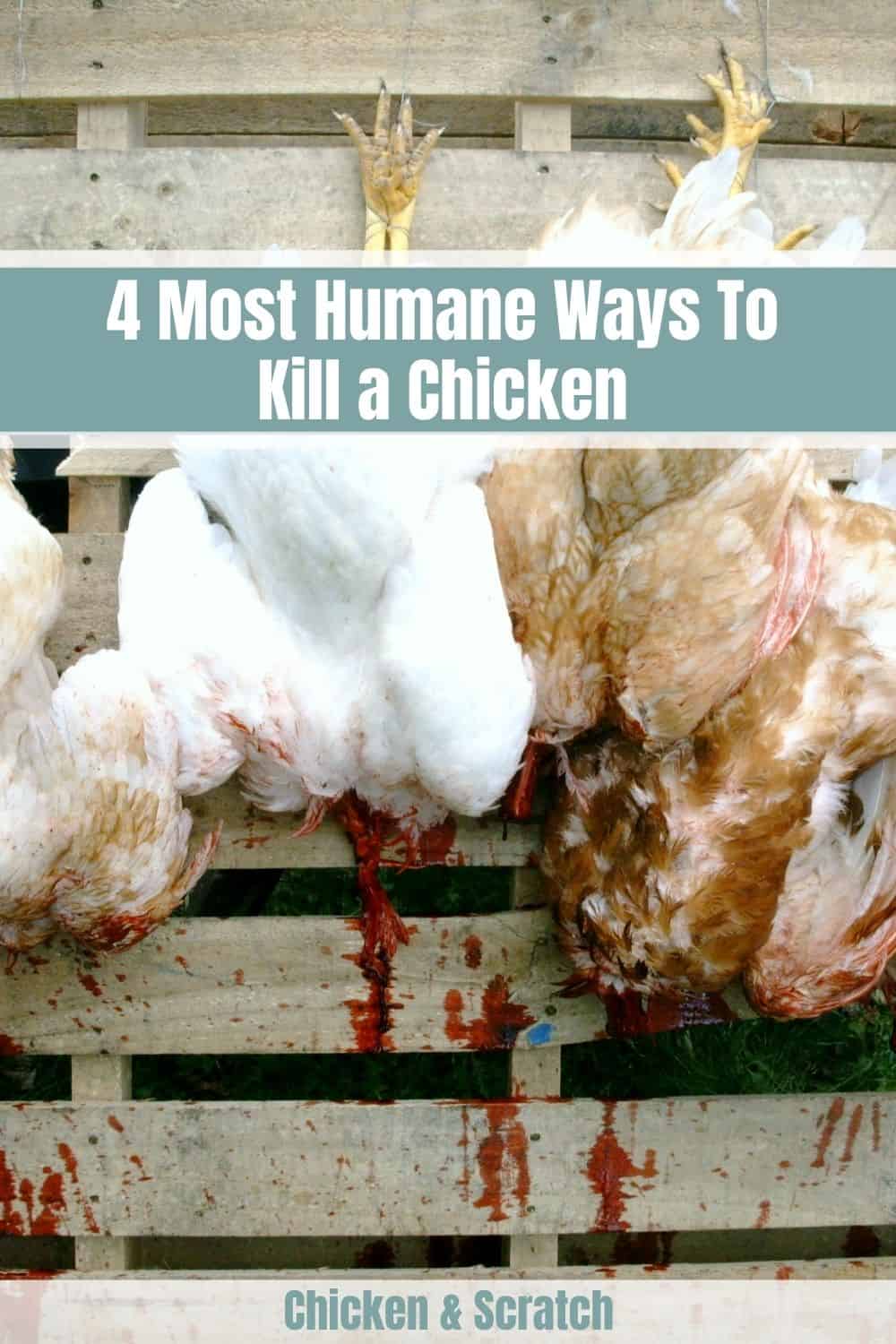
Tips Before Culling Chickens
To start the process of slaughtering chickens at home, it is crucial to follow several key steps. First and foremost, ensure that all required equipment, such as a sharp blade or killing cone, is gathered.
Then choosing an optimal environment to execute this task becomes necessary: pick a location that should be free from other animals and product debris since poultry meat products can remain a hazard post-slaughter processing stage due to the risk of contamination.
It’s vital to always practice strict safety measures during culling by wearing protective gear like gloves, clothing, and eye protection. Following hygiene rules to maintain cleanliness and lessen the risk of bacterial contamination and growth.
Best Ways to Kill a Chicken

There are many ways to kill animals. There seems to be more for chickens, as they are small creatures that are easy to kill. For flock owners keeping chickens for meat, they need to find a way to kill their chickens that works with them. This means they choose a way to kill their flocks according to their resources and what they deem is the best. Here are four ways to kill a chicken.
- Decapitation – By the name itself, you can get the gist of this method. Obviously, it is to stop the chicken’s life by cutting its neck, thus separating the head from its body in a swift blow.
- Gun/Pellet Gun– A pellet gun may seem weak as you read it, but a pellet gun with enough strength to take out a chicken exists. A .22 pistol will usually do.
- Cervical Dislocation– This has been one of the primary methods of killing a chicken. Cervical dislocation also has the benefit of having a bloodless process. This process has two methods: Snapping the head by hand and the broom-stick method.
- CO2 Chamber – This is the only safe way of killing a chicken with the involvement of carbon dioxide. This euthanasia is approved for killing smaller animals such as amphibians, birds, rodents, and other small animals.
In conducting any of the processes, there are things you need to prepare as well as things you need to take note of.
1. Decapitation
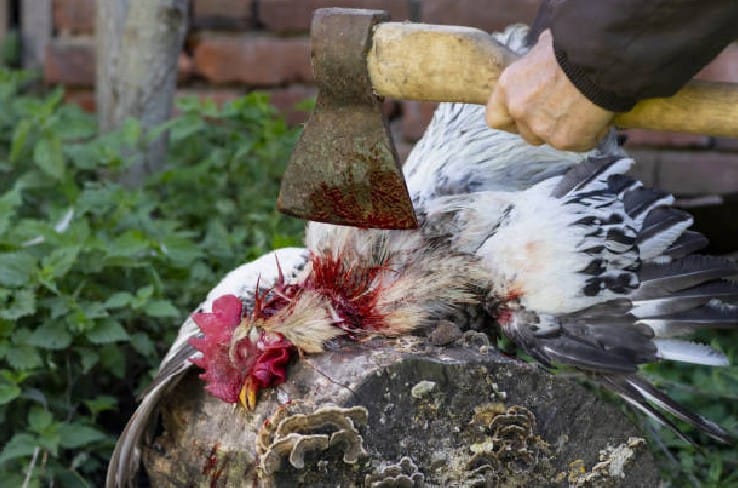
When conducting this method, a sharp knife is essential. An important thing to note is that this process is aimed to be swift and quick. Therefore, the knife to use should be heavy and very sharp.
In conducting the process, you need to have someone with you to assist with the chicken. Doing this alone can be challenging and dangerous, as you can hurt yourself while handling the chicken and the knife.
It’s important to note that the process should be quick and quiet. It’s to avoid having the chicken stressed. Be gentle in handling the bird so as not to cause panic. The process can be bloody, and it certainly is not a good picture, but it’s very much foolproof and won’t hurt your chickens that long. This is as long as your knife is sharp and you swing hard.
- Get your assistant to hold the bird.
- Gently stretch the chicken’s neck for a more precise cut spot.
- Finally, be sure to have the proper calculations. When you do, swing down hard.
2. Gun/Pellet gun

A .22 gun would be enough to snap your chickens. A Pellet gun also works as long as the weapon is a model with enough strength. You should choose a powerful pellet gun to conduct this method.
- This process can be started by wrapping the chicken in a towel.
- Placing and positioning the bird gently on the ground.
- Applying force via kneeling gently on the bird to restrict their movement.
- Finally, use the gun to knock the chicken out.
Cervical Dislocation
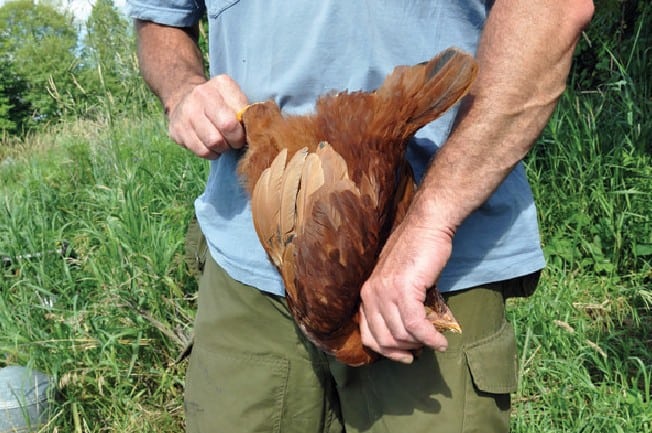
While this can appear like the most basic process, as it only needs hands and strength, cervical dislocation should be done by someone who knows how to do the method properly. In other words, not understanding will cause more harm to the chickens.
So, make sure to execute by following through with this process properly. A lot of people just carelessly break the animal’s neck. And so this results in a painful death as it is not done correctly.
One way of doing this method is by snapping the chicken’s neck by hand. It’s a very personal and hands-on approach to killing chickens. It can be challenging, especially if you do it for the first time. Nevertheless, here is how you should do it.
- Hold your chicken firmly with any hand that feels comfortable.
- Hold the head at the base of its skull.
- Find and feel the place where the skull and neck meet.
- Once you do, snap the chicken’s head downward and outward.
The process is hard to describe, so you would want to learn by visual studying, like researching videos or witnessing this process firsthand.
There is also another method called the broom sticking method. As the name suggests, you would need a broomstick for this process.
- Place the chicken on a hard surface between your feet.
- Place the broomstick behind the chicken’s head. (Basically, just replacing your supposed hand with a broomstick)
- Step down on the broomstick as you pull up the chicken’s back legs, snapping the chicken’s neck.
Again, before conducting this method, doing more research, finding more references, or even trying to witness it in person for a better view is suggested. This is to avoid giving your chickens a more painful death because of malpractice.
CO2 Chamber
This method involves manipulating concentrations of gases, which can be risky if not done properly. Therefore, it’s crucial to fully understand the process and follow the correct safety measures before attempting it. The process involves mixing up the vinegar and baking soda with specific measurements. Basically, enclosing chickens in small spaces and having them inhale carbon dioxide.
Killing Chickens at Home
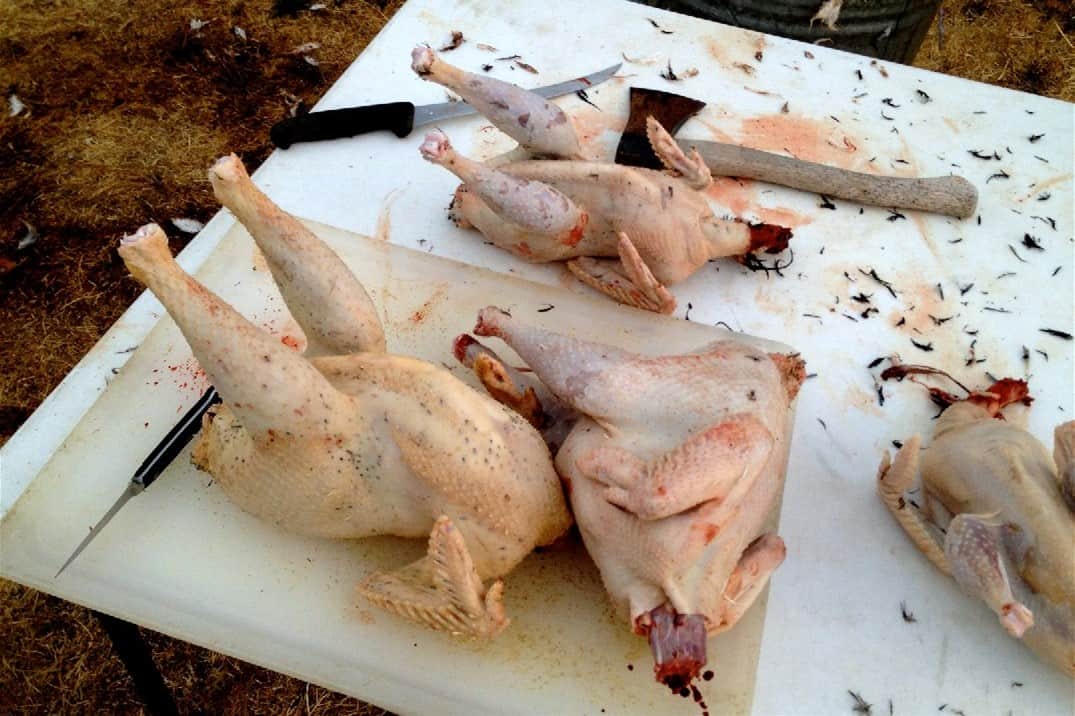
Small-scale flock raisers usually slaughter their chickens at home using the most humane process available.
Suppose you choose to cut your chicken’s jugular vein. In that case, the next thing to do is to drain the blood naturally by having it hanged or having the head of the chicken positioned downward. It’s recommended to use a cone funnel for this purpose to drain blood more effectively.
Using a funnel cone also ensures the chicken’s body is well-secured while blood flows down. The draining process should take about 1.5 minutes to 2 minutes.
Following decapitation, the chicken will bleed extensively. This bleeding is necessary to drain the blood effectively, which in turn simplifies the feather-plucking process.
What to do After Killing the Chicken?
Scalding and Plucking
After letting the chicken bleed to death, the following process is to scald the chicken. What is scalding?
Scalding is the process of getting the chicken through hot or boiling water. It allows the skin to soften up and tighten. It’s a way of preparing the epidermis to make it easier to pluck the feathers up.
Most people are familiar with this method, especially when they have witnessed or experienced slaughtering chickens at home. All you need is a basin and hot water. The appropriate temperature is 60 degrees Celsius or 140 Fahrenheit.
Place the chicken in the basin and have it sit there for about 45 to 60 seconds. Scalding is done to open a part of the chicken called the follicula. The follicula is the part of the chicken and the skin that holds the feathers. Because of this process, feathers are easier to remove.
It is important to note that the plucking should be done immediately after scalding. The scalding effect is lost when you leave the chicken and do not pluck the feathers directly. Another thing is that chickens can get stiff after being left outside after scalding. Note that proper scalding results in minor problems or no problem in plucking all the feathers at all.
Removing Everything Inside (Evisceration)
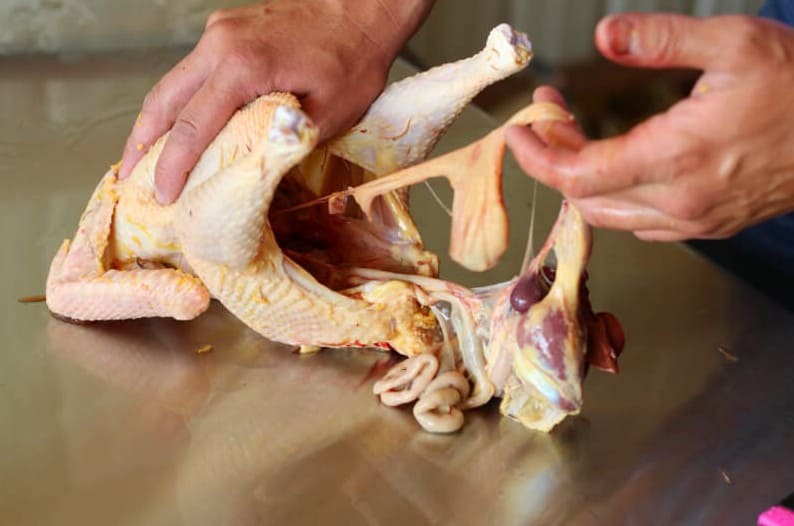
This process is the removal of everything inside the chicken that will not be used for cooking or will be used for cooking other dishes. The parts to be removed also include the head and the feet, as they are usually not used for meat except for some areas where they are cooked and eaten, such as street food or local market food.
The body cavity is usually opened by cutting the bosom or vent (cloacae). Take note that you need to be careful not to cut too rashly. If you injure the intestines, the chicken can be soiled with feces and fecal materials. Once the abdomen is open, you can then remove the viscera.
Washing and Hygiene
After removing everything inside the chicken, it’s time to wash them thoroughly. The table where the butcher conducts the removal process should be cleaned beforehand.
Wherever the chicken meat is placed should be cleansed and disinfected to avoid bacterial contamination. It’s also true when you open up chickens for operation. Cleanliness and proper hygiene are essential and utmost requirements. [How To Clean Chicken Prior to Cooking]
Summary
There are indeed many ways to kill a chicken. Eligible veterinary or animal institutions and associations usually approve methods. Listed here are four ways to kill a chicken, all of which are humane. The rest is now dependent on the butcher, which method is more comfortable and convenient for them.

Joseph Hudson has been raising chickens for over 15 years. In 2018, he completed the Agriculture & Natural Resources program at Mt. San Antonio College. He currently raises over 1400 chickens on his 7.5-hectare farm. He keeps sharing his experience on raising healthy and happy chickens on Chicken Scratch The Foundry.







Disgusting ways to kill a chicken. Sad.
ik the right way, throw em on a bunch of rocks and make em useless. then toss em in the trash and be done with it. wimp
Better than humping it to death like you.
Never eaten chicken I reckon.. prob a super-human vegan in his mommas basement.. loser
how would you kill a chicken
About how much did that first rooster weigh? You said it took roughly 30lbs of force. I have a bunch of 8-10lb broilers to harvest and wondering how they compare to that rooster.
Thank you for explaining it, and also for insisting on not making the animals suffer.